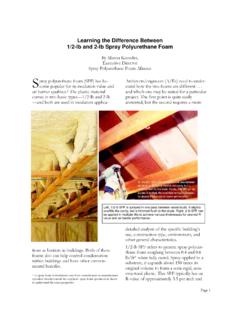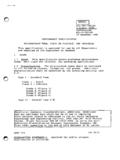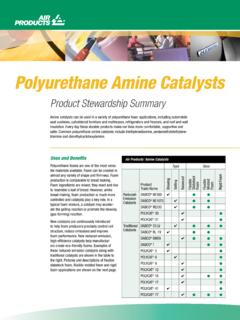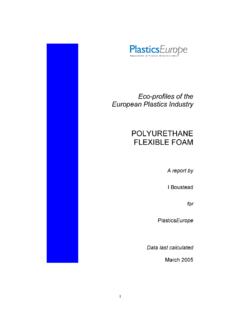Transcription of The Polyurethane Foam Book - Spray Foam …
1 07/13/2006 02:50 PMThe Polyurethane foam book , by David B. SouthPage 1 of 9 Information GoSearch:GOThe MonolithicDome Site Index HomesSchoolsSportsChurchesCommercialNonp rofitStorages FoamAirforms &CoatingsEquipment DisasterResistant Planning &DesignConstruction &Training President'sSphere Dome News Bulletin BoardBuilder ListingsInsuranceLenders WorkshopsConference MarketplaceThe Polyurethane foam BookChapter Five: Fire and Foamby David B. SouthOne of the major reasons I love Monolithic Domes is that they are as close to fireproof as abuilding can be. Yet they have urethane foam -- the world's best insulation as a major , as Paul Harvey would say, let's hear the rest of the story. When I first started in the foam business, I was told that urethane foam was as good as fireproofing.
2 It was rated noncombustible or non-burning. I demonstrated this by taking a piece offoam, setting it on fire with a match or torch and watching it self-extinguish the minute the flamewas taken away. The flames on the foam instantly went out. This is especially true if the surface ofthe foam sample was previously burned, creating a char that protects sales pitches I used in selling my first large foam jobs was telling prospective clients that theycould cancel their fire insurance on their potato storages. I told them that the foam would protectthe metal building so that fire couldn't hurt it. Now, where did I get such information? In 1970, itwas a common misconception and part of the sales patter promoted by urethane foam it turned out, those companies were using ASTM (American Society for Testing and Materials)tests that urethane could easily pass.
3 One of the tests was ASTM 1692-T*. Basically, that test wasperformed by clamping a piece of urethane foam in a stand and putting a flame under an edge ofthe sample for a few seconds. The flame was then moved away, and the lit sample self-extinguished. Because urethane foam easily passed this test, it was designated "self-extinguishingor non-burning."In early 1970, I performed a number of similar experiments: I set blocks of urethane foam on fire,then took the fire away, and the samples flamed out immediately. I concluded that the self-extinguishing tests were valid. But foam doesn't have any large amount of fire retardants andwould not pass any of the fire tests used today. As I eventually learned, those early fire tests werenot of the real world, and so wrong conclusions were real world caught up to us quickly.
4 I started spraying urethane foam in Southeast Idaho in1970. One of my very first jobs was lining the inside of a van body off a two-ton truck. This vanbody was used as a boiler house for a concrete company. We sprayed two inches of foam on thevan's inside. We did this to keep the boiler equipment located within from freezing. But a smallarea of the van's wall, behind some piping, was missed. One night the pipe next to the missed spotfroze, and the operator of the concrete plant proceeded to thaw out the pipes with a propanetorch. The torch set some of the foam on fire. He slapped it out with his hand and thought "thatwas interesting."The operator had been in on some of our discussions and had heard that urethane was virtually fireproof; so he went ahead and put the torch back on the pipes.
5 Suddenly the whole inside of the vancaught on fire and totally burned the interior insulation. The fire was so hot that it melted many ofthe metal parts and destroyed everything within the van body. It lasted less than five minutes, butthe operator felt lucky to get out.*ASTM D 1692 and D 1692T. "Rate of Burning [or] Extent and Time of Burning of Cellular PlasticsUsing a Specimen Supported by a Horizontal Screen." ASTM discontinued these standards in 1978with no that point we decided to reassess this so-called non-burning, self-extinguishing theory. It was07/13/2006 02:50 PMThe Polyurethane foam book , by David B. SouthPage 2 of 9 obvious that foam did burn, and it only self-extinguished when it was all : urethane foam is, far and away, the world's best insulation. So, lining a van with it turns theinside of the van into a reflector oven.
6 Urethane does not burn anything but hot. You cannot startit on fire with out hot heat. But once it starts to burn in the reflector oven, the temperature risesastronomically. In literally an instant, the fire grows very hot, and the hotter it gets, the hotter andfaster it burns. We discovered, quite by accident, something the fire industry also learned: so-called self-extinguishing foam does, in fact, burn very well. We later learned about other foam firesaround the United States and in other countries, similar to our van fire. Some involved it turns out, a urethane foam that does not create a fire hazard under certain conditions simplydoes not exist. This is not because foam burns so well. It is because foam insulates so , most modern urethane foams do not burn very well. Most of these are called ULrated or Class I foams and have a flame spread of less than 25.
7 (Flame spread rating isexplained in the Appendix.) But even these more highly fire-retardant foams can be a fire , that's not because the foam burns -- most won't burn but very little when isolated. Thehazard exists because foam is such a superior of this superiority, urethane foam , left exposed as a lining of a building, helps create areflector oven in the building's interior. So, the heat from a fire started within the confines of thebuilding has no place to go. The heat radiates from the fire to the foam and back to the fire, againand again. The temperature rise is phenomenal! An Upjohn engineer told me that a normal houseburns at about 3500 F -- maximum temperature. Fire temperatures within a urethane foam linedmetal building will hit 10,000 F within 30 matters little if urethane is most fire-retardant or least fire-retardant; if a fire gets going in abuilding lined with exposed urethane, the foam accelerates the fire.
8 This is because urethane foamwill not absorb any significant amount of heat. Obviously, this is more of a problem if the walls andthe ceiling are both insulated than if just the ceiling is insulated. It is even more of a problem if thebuilding contains flammable materials. In any case, those so called noncombustible foams turnedout to be a very serious fire hazard. The urethane industry had advertised the foams as self-extinguishing or nonburning. After a number of fires, the Federal Trade Commission stepped in andsued major urethane suppliers. The FTC and the suppliers came up with a consent decree: theurethane suppliers would fund new testing and stop promoting foam as nonburning or self-07/13/2006 02:50 PMThe Polyurethane foam book , by David B. SouthPage 3 of 9 Mutual Insurance and Underwriters Laboratories also got into the act.
9 They devised moreappropriate tests and determined that the only way to protect foam from fire in any circumstancewas to use a thermal barrier. Originally the approved thermal barriers were 3/4 of an inch ofplaster or 1/2 inch of sheet rock over the urethane foam . Since then, a number of other productshave been tested and approved as fire Appendix includes a description of the Factory Mutual test. Anyone who has a fire barrier andwants to test it can do so either with a full scale Factory Mutual corner test or a small scale cornertest, that is now also being administered by some of the other testing labs. The point is, urethaneis such an exceptional insulation it creates its own fire hazard by being such a super insulation. Onthe other hand it also acts as a fire are examples of urethane as a fire hazard and as a fire as a Fire HazardExample -- Sugar Beet StorageIn 1972 Toppenish, Washington, we insulated a huge, rigid-frame, metal building used for sugarbeet storage.
10 It was 120' wide by 400' long, with a 28' height at the eaves and a center height ofapproximately 45'. It had a 60'x 20' doorway as the entrance in one end. For insulation, wesprayed 3 inches of urethane over the entire interior surfaces -- ceiling and the first year of storing sugar beets, the owners discovered the heat given off by the sugarbeets was more than anticipated and the beets needed more next summer while the building was empty, a crew of men was told to cut additional vents inthe structure. While cutting the opening for the first vent, they were extremely careful about chipped the foam off the metal for an area considerably larger than the vent, and they putwet burlap on the foam surrounding the area to be removed. Then using a cutting torch, theyremoved a section of the building to provide space for the the workmen continued from vent to vent, they found that the urethane would ignite but wouldvery quickly self-extinguish -- there didn't seem to be a problem.




